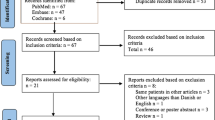Abstract
Objective
Dysphagia can be troublesome in sporadic inclusion body myositis (sIBM) and oculopharyngeal muscular dystrophy (OPMD), but no established treatment exists. Cricopharyngeal muscle botulinum toxin injection has at case level been reported to be effective. We evaluated safety and efficacy of botulinum toxin injections in the cricopharyngeal muscle in patients with dysphagia due to sIBM or OPMD.
Methods
Participants were included from our outpatient clinic. Cricopharyngeal constriction was confirmed by laryngoscopy. After EMG confirmation of needle placement in the cricopharyngeal muscle, botulinum toxin A was injected in awake patients. An individualized dose of 5–10 units of botulinum toxin A was applied initially and titrated up a maximum of 3 times. Outcome measures were change in dysphagia questionnaire, timed cold-water swallow test and subjective dysphagia status (worse, unchanged, improved). Due to the need for individualized dosing and a limited number of available patients, an uncontrolled, un-blinded design was used.
Results
Thirteen patients, 3 with OPMD, received at least 1 injection. In the dysphagia questionnaire, all but 2 subjects, none with subjective worsening, improved (p < 0.001). Subjectively, seven felt an improvement, 4 no change and 2 a worsening. No overall change was seen the timed cold-water swallow test. No serious adverse events were observed.
Conclusion
Botulinum toxin injection of the cricopharyngeal muscle in patients with OPMD and sIBM had a beneficial effect on dysphagia in most of the treated patients. Two of 13 patients experienced a temporary worsening not reflected in dysphagia score. Limitations are the un-blinded and un-randomized design and subjective assessments methods.
Prospective trial registration
EudraCT-number: 2014-002210-23.



Similar content being viewed by others
References
Schrey A, Airas L, Jokela M, Pulkkinen J (2017) Botulinum toxin alleviates dysphagia of patients with inclusion body myositis. J Neurol Sci 380:142–147
Oh TH, Brumfield KA, Hoskin TL, Stolp KA, Murray JA, Bassford JR (2007) Dysphagia in inflammatory myopathy: clinical characteristics, treatment strategies, and outcome in 62 patients. Mayo Clin Proc 82:441–447
Alonso-Jimenez A, Kroon R, Alejaldre-Monforte A et al (2019) Muscle MRI in a large cohort of patients with oculopharyngeal muscular dystrophy. J Neurol Neurosurg Psychiatry 90:576–585
Price MA, Barghout V, Benveniste O et al (2016) Mortality and causes of death in patients with sporadic inclusion body myositis: survey study based on the clinical experience of specialists in Australia, Europe and the USA. J Neuromuscul Dis 3:67–75
Taira K, Yamamoto T, Mori-Yoshimura M et al (2020) Obstruction-related dysphagia in inclusion body myositis: Cricopharyngeal bar on videofluoroscopy indicates risk of aspiration. J Neurol Sci 413:116764
Coiffier L, Perie S, Laforet P, Eymard B, St Guily JL (2006) Long-term results of cricopharyngeal myotomy in oculopharyngeal muscular dystrophy. Otolaryngol Head Neck Surg 135:218–222
Haapaniemi JJ, Laurikainen EA, Pulkkinen J, Marttila RJ (2001) Botulinum toxin in the treatment of cricopharyngeal dysphagia. Dysphagia 16:171–175
Litchy WJ, Engel AG (1992) Inclusion body myositis with cricopharyngeus muscle involvement and severe dysphagia. Muscle Nerve 15:115
Liu LW, Tarnopolsky M, Armstrong D (2004) Injection of botulinum toxin A to the upper esophageal sphincter for oropharyngeal dysphagia in two patients with inclusion body myositis. Can J Gastroenterol 18:397–399
Oh TH, Brumfield KA, Hoskin TL, Kasperbauer JL, Basford JR (2008) Dysphagia in inclusion body myositis: clinical features, management, and clinical outcome. Am J Phys Med Rehabil 87:883–889
Shaw GY, Searl JP (2001) Botulinum toxin treatment for cricopharyngeal dysfunction. Dysphagia 16:161–167
Mohannak N, Pattison G, Radich B et al (2020) Exploring the efficacy of the expiratory muscle strength trainer to improve swallowing in inclusion body myositis: a pilot study. Neuromuscul Disord NMD 30:294–300
Taira K, Yamamoto T, Mori-Yoshimura M et al (2021) Cricopharyngeal bar on videofluoroscopy: high specificity for inclusion body myositis. J Neurol 268:1016–1024
Youssof S, Schrader RM, Romero-Clark C, Roy G, Spafford M (2013) Safety of botulinum toxin for dysphagia in oculopharyngeal muscular dystrophy. Muscle Nerve. https://doi.org/10.1002/mus.24123
Restivo DA, Marchese RR, Staffieri A, de Grandis D (2000) Successful botulinum toxin treatment of dysphagia in oculopharyngeal muscular dystrophy. Gastroenterology 119:1416
Moerman MB (2006) Cricopharyngeal Botox injection: indications and technique. Curr Opin Otolaryngol Head Neck Surg 14:431–436
Di PC, Masiero S, Bonsangue V, Ragona RM, Del FA (2016) Botulinum toxin and rehabilitation treatment in inclusion body myositis for severe oropharyngeal dysphagia. Neurol Sci 37:1743–1745
Di Pede C, Masiero S, Bonsangue V, Ragona RM, Del Felice A (2016) Botulinum toxin and rehabilitation treatment in inclusion body myositis for severe oropharyngeal dysphagia. Neurol Sci 37:1743–1745
Griggs RC, Askanas V, DiMauro S et al (1995) Inclusion body myositis and myopathies. Ann Neurol 38:705–713
Bouchard JP, Marcoux S, Gosselin F, Pineault D, Rouleau GA (1992) A simple test for the detection of dysphagia in members of families with oculopharyngeal muscular dystrophy (OPMD). Can J Neurol Sci 19:296–297
Cox FM, Verschuuren JJ, Verbist BM, Niks EH, Wintzen AR, Badrising UA (2009) Detecting dysphagia in inclusion body myositis. J Neurol 256:2009–2013
Funding
The study was not funded.
Author information
Authors and Affiliations
Contributions
NW: planned and executed the study, carried out the statistical analysis and is the corresponding author, HB, LPD, SP and DD contributed importantly to collection and data and preparation of manuscript, JV partipated in conception and planning of the study besides preparation of the manuscript.
Corresponding author
Ethics declarations
Conflicts of interest
None of the authors have financial or non-financial interests to disclose.
Ethical approval
The authours state that the study adhere to the COPE guidelines.
Rights and permissions
About this article
Cite this article
Witting, N., Daugaard, D., Prytz, S. et al. Botulinum toxin treatment improves dysphagia in patients with oculopharyngeal muscular dystrophy and sporadic inclusion body myositis. J Neurol 269, 4154–4160 (2022). https://doi.org/10.1007/s00415-022-11028-8
Received:
Revised:
Accepted:
Published:
Issue Date:
DOI: https://doi.org/10.1007/s00415-022-11028-8




